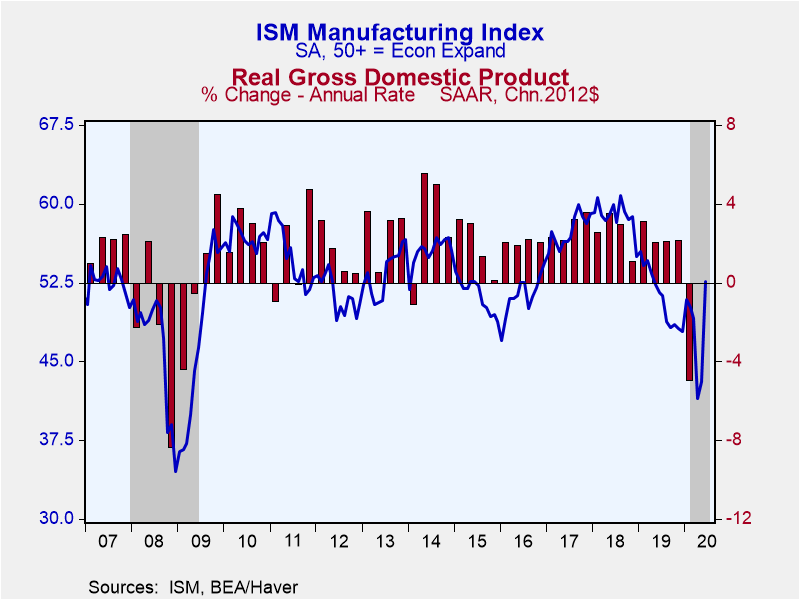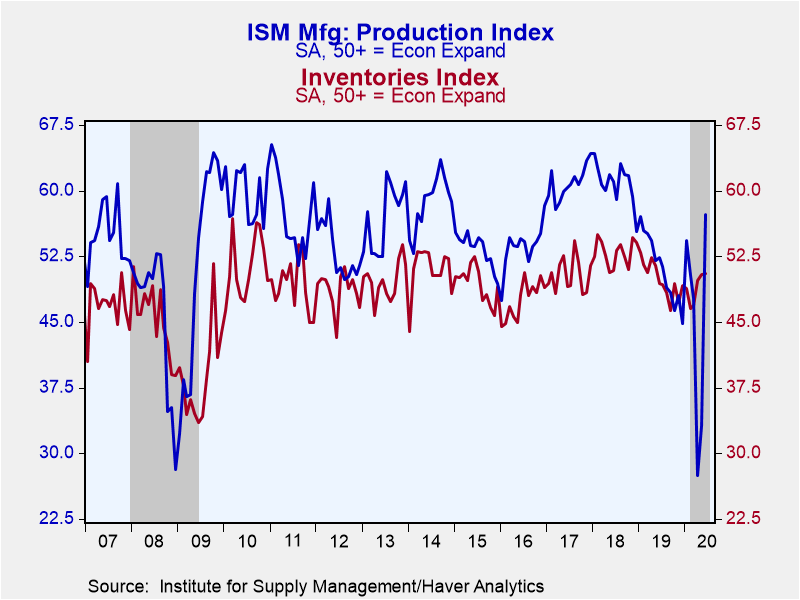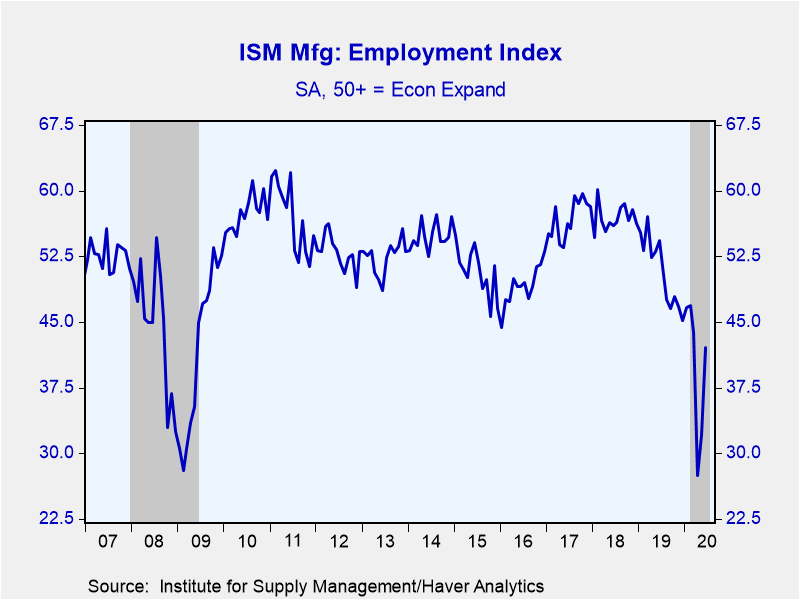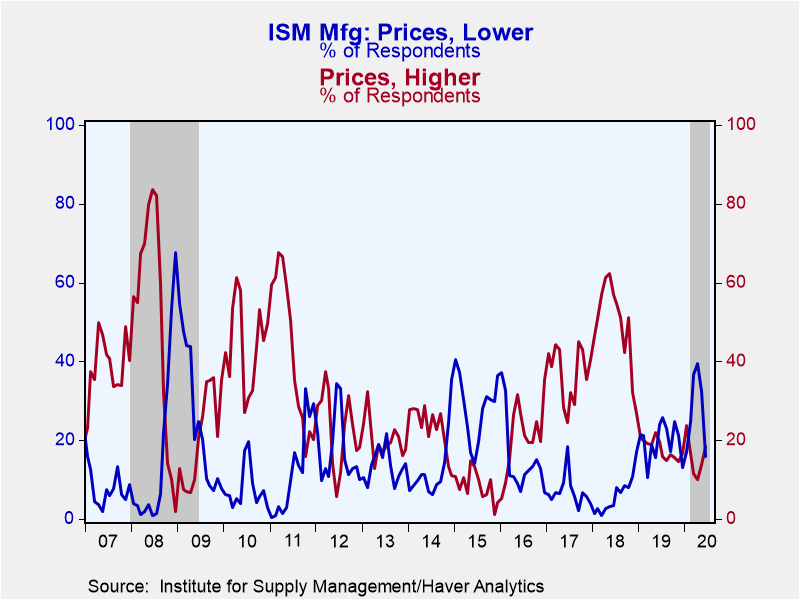 Global| Jul 01 2020
Global| Jul 01 2020ISM Manufacturing Index Surges in June
by:Tom Moeller
|in:Economy in Brief
Summary
• Composite Index moves above break-even for first time since February. • Component series improvement is widespread. • Price index rises sharply. The Institute for Supply Management (ISM) reported that its Composite Index of [...]
• Composite Index moves above break-even for first time since February.
• Component series improvement is widespread.
• Price index rises sharply.
The Institute for Supply Management (ISM) reported that its Composite Index of Manufacturing Sector Activity increased to 52.6 during June after improving to 43.1 in May. The index increase followed three consecutive readings below the break-even level of 50. The Action Economics Forecast Survey expected 47.9. During the last 15 years, there has been a 66% correlation between the composite index and the quarterly change in real GDP.
The production index exhibited the largest component strength as it rose to 57.3 from 33.2 in May. An improved 39% (NSA) of respondents reported higher production while a greatly lessened 23% reported a decline. The new orders index followed with a rise to 56.4 from 31.8. A strengthened 37.3% (NSA) of survey respondents reported higher new orders, the most in two years. Twenty-four percent reported fewer orders, half the May reading.
Adding to the improvement was a rise in the employment measure to 42.1, which followed an increase to 32.1 in May. Despite the gain, the index remained below its peak of 60.1 reached in February 2018. Just fifteen percent (NSA) of respondents reported higher payrolls while a lessened 27% reported declines.
The supplier delivery measure decreased to 56.9 from 68.0, indicating fewer bottlenecks in the supply chain. It was the lowest level since January. The inventories measure rose negligibly to 50.5 and remained below the February 2018 peak of 55.0.
The prices paid index increased to 51.3 (NSA), the highest level in five months. A still depressed 19% of respondents reported higher prices while a lessened 16% reported declines.
Other series in the ISM report indicated improvement. The export order measure increased to 47.6 from 39.5, but remained below a high of 62.8 in February 2018. The import series surged to 48.8, close to its expansion low in May, while the order backlog measure also increased sharply.
The ISM figures are based on responses from over 400 manufacturing purchasing executives from 20 industries, which correspond to their contribution to GDP in 50 states. The ISM figures are diffusion indexes where a reading above 50 indicates expansion. The figures from the Institute for Supply Management can be found in Haver's USECON database; further detail is found in the SURVEYS database. The expectations number is available in Haver's AS1REPNA database.
The Unequal Impact of COVID-19: Why Education Matters from the Federal Reserve Bank of San Francisco is available here.
| ISM Mfg (SA) | Jun | May | Apr | Jun'19 | 2019 | 2018 | 2017 |
|---|---|---|---|---|---|---|---|
| Composite Index | 52.6 | 43.1 | 41.5 | 51.6 | 51.2 | 58.9 | 57.4 |
| New Orders | 56.4 | 31.8 | 27.1 | 50.5 | 51.1 | 61.6 | 62.1 |
| Production | 57.3 | 33.2 | 27.5 | 52.4 | 51.2 | 60.9 | 60.9 |
| Employment | 42.1 | 32.1 | 27.5 | 54.3 | 50.9 | 56.9 | 56.8 |
| Supplier Deliveries | 56.9 | 68.0 | 76.0 | 51.2 | 52.9 | 62.0 | 56.8 |
| Inventories | 50.5 | 50.4 | 49.7 | 49.4 | 49.8 | 52.9 | 50.4 |
| Prices Paid Index (NSA) | 51.3 | 40.8 | 35.3 | 47.9 | 49.1 | 71.7 | 65.0 |
Tom Moeller
AuthorMore in Author Profile »Prior to joining Haver Analytics in 2000, Mr. Moeller worked as the Economist at Chancellor Capital Management from 1985 to 1999. There, he developed comprehensive economic forecasts and interpreted economic data for equity and fixed income portfolio managers. Also at Chancellor, Mr. Moeller worked as an equity analyst and was responsible for researching and rating companies in the economically sensitive automobile and housing industries for investment in Chancellor’s equity portfolio. Prior to joining Chancellor, Mr. Moeller was an Economist at Citibank from 1979 to 1984. He also analyzed pricing behavior in the metals industry for the Council on Wage and Price Stability in Washington, D.C. In 1999, Mr. Moeller received the award for most accurate forecast from the Forecasters' Club of New York. From 1990 to 1992 he was President of the New York Association for Business Economists. Mr. Moeller earned an M.B.A. in Finance from Fordham University, where he graduated in 1987. He holds a Bachelor of Arts in Economics from George Washington University.










